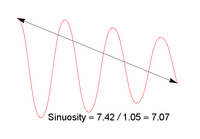Sinuosity

Okay, so let's imagine that you're drawing a line on a piece of paper. You want this line to be very wiggly, kind of like a snake, instead of straight like a pencil or ruler. This wigglyness is what we call "sinuosity"!
Basically, sinuosity is a fancy way of describing how curvy or twisty a line is. It's often used to describe rivers or streams, where the path of the water can twist and turn as it flows downhill. The sinuosity of a river is calculated by measuring how long the river is if you were to follow it along every twist and turn, and comparing that to how long the river would be if it just went straight from start to finish.
So if a river has a sinuosity of 1, that means it's perfectly straight like a line on a ruler. But if it has a sinuosity of 2 or more, that means it's very twisty and curvy like a snake. In fact, some rivers can have sinuosity values of 4 or 5, which means they're so twisty that they actually end up flowing back on themselves like a pretzel!
Sinuosity is important to study because it can tell us a lot about how a river moves and changes over time. A river with high sinuosity might be slow and meandering, with lots of curves and bends. On the other hand, a river with low sinuosity might be fast and straight, like a rushing mountain stream. Scientists study sinuosity to learn about how rivers form, how they erode the land around them, and how they interact with plants and animals that live nearby.
Basically, sinuosity is a fancy way of describing how curvy or twisty a line is. It's often used to describe rivers or streams, where the path of the water can twist and turn as it flows downhill. The sinuosity of a river is calculated by measuring how long the river is if you were to follow it along every twist and turn, and comparing that to how long the river would be if it just went straight from start to finish.
So if a river has a sinuosity of 1, that means it's perfectly straight like a line on a ruler. But if it has a sinuosity of 2 or more, that means it's very twisty and curvy like a snake. In fact, some rivers can have sinuosity values of 4 or 5, which means they're so twisty that they actually end up flowing back on themselves like a pretzel!
Sinuosity is important to study because it can tell us a lot about how a river moves and changes over time. A river with high sinuosity might be slow and meandering, with lots of curves and bends. On the other hand, a river with low sinuosity might be fast and straight, like a rushing mountain stream. Scientists study sinuosity to learn about how rivers form, how they erode the land around them, and how they interact with plants and animals that live nearby.
Related topics others have asked about:
